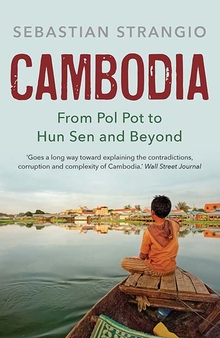A Mirage on the Mekong
Sebastian Strangio—
In the West, Cambodia is nearly synonymous with the terror and mass murder that engulfed the country in the mid-1970s, when the Khmer Rouge seized power and embarked on a radical experiment in communism. Led by “Brother Number One” Pol Pot, who dreamt of recreating the glories of Angkor, Cambodia’s powerful premodern empire, the Khmer Rouge set about forging an agrarian arcadia of stark and uncompromising purity. They emptied the cities, abolished money, banned religion, and put the population to work in vast labor camps. For almost four years, Cambodia retreated from the world. By the time “Democratic Kampuchea” collapsed in early 1979, an estimated 1.7 million Cambodians—about a quarter of the population—had perished and a green land had been sown with hundreds of mass graves.
Even now, four decades on, the name of this small country still has the power to conjure. Cambodia remains an international shorthand for suffering; a hazy land of skulls and spires; an ancient civilization slipped from glory and sunk, inexplicably, in madness. “I have a gloomy view of Cambodia,” Henry Kamm once remarked, reflecting on the two decades he spent covering the country for the New York Times. “It is a nation at the end of its parabola of life.”But despite its dark history, the Cambodian arc persists. After many years, it is finally a country at peace and open to the world. Millions of foreign tourists visit each year to marvel at the temple- city of Angkor Wat, one of the wonders of the premodern world. Today’s visitor encounters a friendly people and a small country rushing to catch up with the future, seemingly impatient to leave a horrific past behind.
Cambodia’s journey to the present has been tumultuous. For two decades after their overthrow by the Vietnamese army in 1979, the Khmer Rouge lived on. Throughout the 1980s, China, the US, and their Southeast Asian allies cynically preserved the movement as a bulwark against the new Soviet- aligned regime that had replaced it in Phnom Penh. The ensuing civil war dragged on for more than a decade. Then, as the Cold War thawed and a new international order dawned, Cambodia was repackaged as a democracy. A peace plan was signed and the country became the subject of one of the most ambitious and expensive United Nations peacekeeping missions ever mounted. After years of isolation, Cambodia opened to the world. Nongovernmental organizations and charities mushroomed. Foreign aid typhooned in. A victim of Cold War power politics was offered the blessings of a global community newly confident in its ability to plan and engineer democratic government.
But the democratic renaissance, such as it was, was short- lived. The government that took office following the UN-organized 1993 election was an unsteady coalition between Hun Sen of the Cambodian People’s Party (CPP), which had ruled the country since 1979, and Prince Norodom Ranariddh, the son of Norodom Sihanouk, who had led Cambodia to independence in 1953. Neither leader had much interest in democracy. Cambodians had lived under authoritarian leaders since the time of Angkor, and it wasn’t long before the old patterns reasserted themselves. In 1997, Hun Sen ousted Ranariddh by force and seized power for himself, leaving the UN’s democratic plans in tatters.
The CPP’s stabilizing power brought decades of war to an end and opened Cambodia to economic development and investment from abroad. When the Khmer Rouge finally withered in the late 1990s, a new chapter in the country’s history began—an era of peace and economic advancement. But beneath a surface sheen of modernity and pluralism, Hun Sen continued to rule in the old way, through guile and force, through gifts and threats, through an intricate hierarchy of status and power. He has been in control of the country ever since.
From Cambodia by Sebastian Strangio. Published by Yale University Press in 2020. Reproduced with permission.
Sebastian Strangio is a former reporter and editor at the Phnom Penh Post, Cambodia’s oldest English-language newspaper. He is currently a journalist and independent analyst focusing on Southeast Asia.
Further Reading:
























